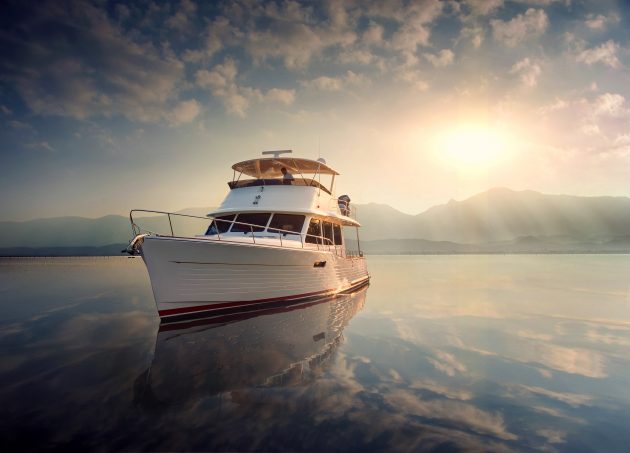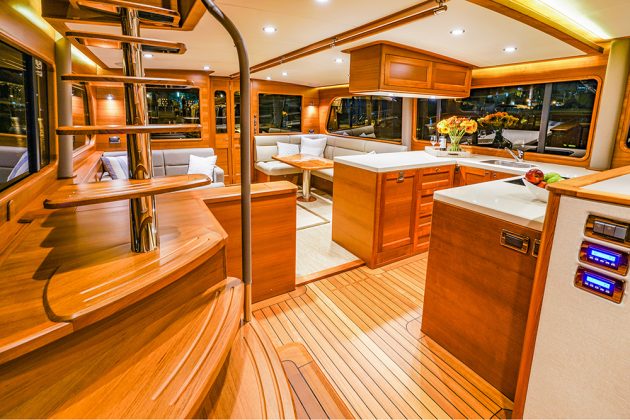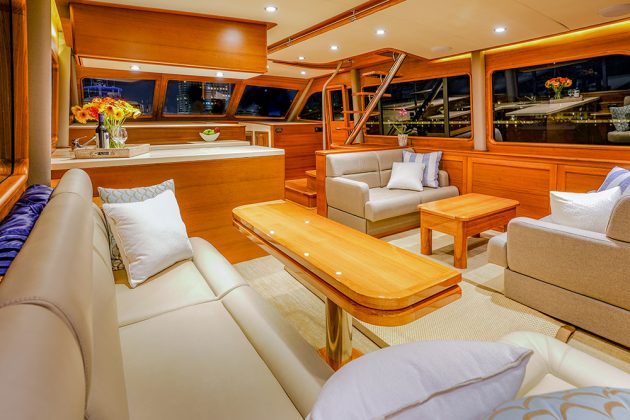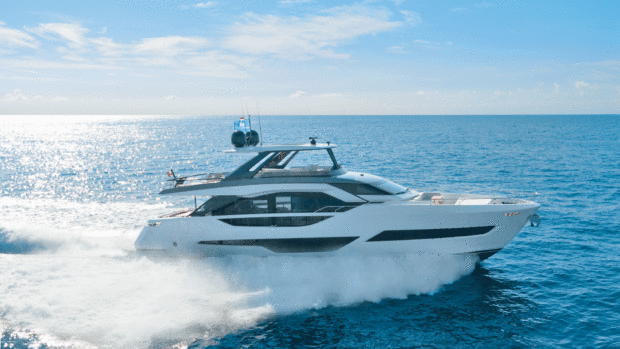Grand Banks' new flagship, Grand Banks 60 Fly SL, has some bold performance claims so a trial in Floridian home waters was the perfect way to put them to the test
The mangrove-fringed waterway that leads to Grand Banks’ sales office and service facility in Stuart, Florida is shrouded in eerie calm. The surface of the water is mirror smooth, the milky sky and vegetation, which verges on Amazonian, is reflected so perfectly you could flip the vista upside down unnoticed. The fairway is narrow and shallow; there is about 3ft (0.91m) of liquid between the muddy bed and the twin five-blade props that are gingerly being fed power from a pair of 800hp Volvo Penta D13s by skipper Mark. “This route out to the main waterway takes some learning,” he says “and it’s quite a challenge in the dark.” I’ll say. This tributary that bends and twists out to the St Lucie River isn’t marked, lit or even dredged. The profile of the bottom is changeable and, at certain hairpins, there would be little space for two boats the size of the 60 Fly to pass each other. We pass waterside houses that peer out from thick greenery, barely keeping nature’s grasp at bay. This isn’t just boating in a different country; it’s boating on a different planet.
Purring along
We are surveying this scene from the sealed luxury of the 60 Fly’s Sky Lounge, a £235,153 option over the standard open version (pictured on the cover) where you find the helm station, a dinette, day head. It’s an extraordinary sensation to pilot this boat with 1,600hp in the engineroom and feel so beautifully cut off from the noise and commotion of travel. Grand Banks builds quiet boats but this luxurious, elevated cocoon takes refinement to another level. Engines? What engines?
As we trickle out towards the open sea the only indication that the motors are pushing us along is the flicker of the needles on the rev counter. To compare the driving experience to a Rolls-Royce Phantom would be lazy but, there you go, I’ve done it.
You sit on fully adjustable Stidd thrones with a commanding view of the boat’s elegant foredeck via three gently sloped windscreens trimmed in thick teak. The wooden steering wheel is of generous diameter yet thin-rimmed and delicate – you guide
the boat with fingertips, not clenched fists.
We join the main waterway and head out into the foothills of the North Atlantic via a lifting road bridge at the St Lucie inlet.
Grand Banks has published some eyebrow-raising economy figures for the 60, which is available with IPS or the shaft drives that we have on test. With IPS1200 (900hp per side) the yard claims that at 10 knots the range is over 2,500 nautical miles and flat-out at 36 knots it will still manage an astonishing 648 nautical miles. The numbers for the shaft alternative are no less eye-catching: 2,000nm miles at 10 knots, 536nm flat-out at 31 knots and over 800nm at 20 knots. You can, in theory, cover thousands of miles at displacement speeds like the classic Grand Banks of old, but this new generation can also swallow up huge journeys at real pace. The driving force behind these performance and efficiency targets is CEO Mark Richards.
The Australian maxi-yacht racer and founder of Palm Beach Motor Yachts sold the business to Grand Banks before joining
the American yard full time. With him came an appetite for efficiency and knowledge of materials that is evident in the
way the boats are built and their performance. The deck and superstructure are made with resin-infused, cored carbon fibre
in a bid to keep the centre of gravity as low as possible and negate the extra 750kg that the Sky Lounge carries over the open.
The hull is super smooth and devoid of any unnecessary submerged extremities that could induce dreaded drag. Why, then, fit Sleipner’s Vector fin stabilisers instead of a gyroscope? The team contests that across the speed range, fins are more effective, especially with the zero speed stabilisation functionality, and that the curve of the latest ones actually provides added lift, so the detrimental effect on performance is minimal. They certainly earn their keep on the Sky Lounge, which as well as having a lot of structure up high has a tender with a 30hp Yamaha on the back chocked on the aft end of the top deck.

Our boat is fitted with the 800hp version of the D13s but, going forward, the 900hp lumps on the same block will be standard. Even with the 200hp deficit, transition on to the plane is effortless. The hull is shallow at the stern and provides plentiful lift to get the pin-sharp bow section slicing through the water. The natural balance of this hull is outstanding, the running attitude tabletop-level without the need to be constantly tweaking the Zipwake trim system.
Progress is utterly serene, noise levels only just nudging over 61dB(A) at 20 knots. We achieved a two-way top speed of 25.8 knots with half fuel and full water on board but at full revs there was noticeable reverberation detectable even in the lofty isolation of the sky lounge. Grand Banks has since put this down to a tiny misalignment of one of the engines and a loose coupling. The conditions we faced didn’t mount a serious challenge to the 60’s progress but the placid seas gave the boat’s handling a chance to shine. It is far more engaging to chuck around than its looks suggest. The steering is light, quick between locks and, though there is no lean in hard turns, the bow swings around obediently belying the boat’s towering profile. One can only imagine what a riot the 36-knot open variant would be.

Despite the enclosed flybridge you aren’t entirely cut off from your surroundings because both side windows, the aft window and a pair of hatches in the roof open to allow the breeze to wash through the interior. The skipper can’t communicate as easily with crew compared to an open flybridge but a smart touch, be it by luck or design, is that the helmsman can check their proximity to the dock on the starboard side thanks to the sightline from the upper helm through the saloon window on the main deck.
Custom option
This particular boat – hull no.8 of the Sky Lounge version – had a day heads on the top deck but Grand Banks has built boats with a bureau or more seating instead. As useful as the day heads is, given the next closest loo is on the lower deck, it gobbles up quite a lot of space and blocks the view out from the dinette.
The yard is open to customisation and, though you pay for the privilege, flexibility is one of the key attractions. One customer, for instance, added a berth to the top deck and direct access from the cockpit via a ladder, so the skipper had his own self-contained apartment. For me an obvious improvement on the SL would be to shift the tender down on to the bathing platform so the top deck can be fitted with sun pads or a dinette to boost outdoor living space. In a similar vein, that pronounced coachroof is crying out for some sun-bathing cushions.
Much of the main deck is shared with the standard 60 but, due to the need for an internal staircase on the SL, the saloon layout is quite different. There’s no need for a lower helm and the galley shifts from a position aft to one forward, adjacent to the internal stairs. This leaves a comfortable dinette amidships with a folding teak table and stools that can be brought up to
the inboard side to seat a couple more guests for dinner.

The area opposite has a pair of cosy settees facing each other with an attractive teak coffee table in between. It’s a relaxed, intimate little space perfect for a morning coffee or glass of red wine in the evening within the soothing surroundings of a saloon bursting with home-from-home comfort. The interior of the 60 is a simply lovely place to be; warm, inviting, practical and hewn from seriously solid materials that reassure you that the boat will withstand harsh conditions. It’s not perfect, however.

The counter tops lack fiddled edges so it’s all too easy for loose items to slide off them and though drawer cooling space in the galley is supplemented by more in the cockpit, there isn’t a domestic fridge-freezer. Nor is there a full-beam master cabin, which will be an issue for some given this is a 65ft boat costing over £3.8m to this specification. Grand Banks stands by its layout, however, which in fairness works very nicely.

The master cabin is arranged along the port side and it is still an impressive space, which is surprisingly bright given the lack
of hull windows. It has a large island berth, masses of full-height cupboard storage at the aft end, and a spacious, light-filled ensuite. The VIP cabin is forward and shares a bathroom with the third cabin to starboard, which has two single berths arranged in a staggered L shape that are probably best suited to small children.

Breeding intact
Has Grand Banks, in an effort to modernise the brand, abandoned the roots that have helped it to build such a strong reputation? Absolutely not, and that is what is so clever about the 60. The familiar Grand Banks touch points are proudly on show. There are aesthetic nods like the varnished transom and the grooves in the topsides designed to look like planking, but the practical detailing is in place, too. There are shore power sockets at the stern and at the bow and fuel filler caps on both sidedecks even though they feed the same tank.
A deck hatch in the cockpit lifts to reveal a sizeable utility room and lazarette with a watertight door forward that leads
to an immaculate engineroom. It’s tight on headroom but the installation is flawless and expertly engineered.
The price of the 60 is rub-your-eyes-in-disbelief high and it’s not helped by the current exchange rate. But the financial blow
is softened somewhat when you dig beneath the surface and discover just how well put together and intelligently crafted this handsome and capable boat is.
Grand Banks has expertly navigated the conundrum of moving the brand forward, without abandoning what it is best known for. The wholesome spirit of the traditional Grand Banks is alive and well within the 60 but as a way to travel or tool to cruise on – whether it be a displacement speed overnighter or 25-knot romp across the bay – it is bang up to date.
At a glance…
LOA: 65ft 4in (19.9m)
Beam: 19ft 2in (5.85m)
Draught: 4ft 4in (1.3m)
Displacement: 28 tonnes
Fuel capacity: 5,800 litres
Water capacity: 1,100 litres
Contact: Grand Banks










